The Impact of Corporate Tax Reduction on Australian Governance
VerifiedAdded on 2021/06/14
|17
|3793
|488
Project
AI Summary
This research proposal examines the impact of reducing corporate taxation rates on the corporate governance of organizations in Australia. The study investigates the interaction between corporate taxation and corporate governance, considering the current debate around corporate tax rates in Australia and the government's proposed tax reduction plan. The research reviews existing literature on corporate taxation, corporate governance, and their interplay, including the Australian context. It formulates a hypothesis on the impact of tax reduction on governance, arguing that lower tax rates may improve managerial diversion levels and overall corporate governance. The methodology section outlines the data collection methods, sampling techniques, and variables of interest. The proposal concludes with a discussion of the potential implications of the research, emphasizing the complex relationship between corporate tax policies and corporate governance practices.
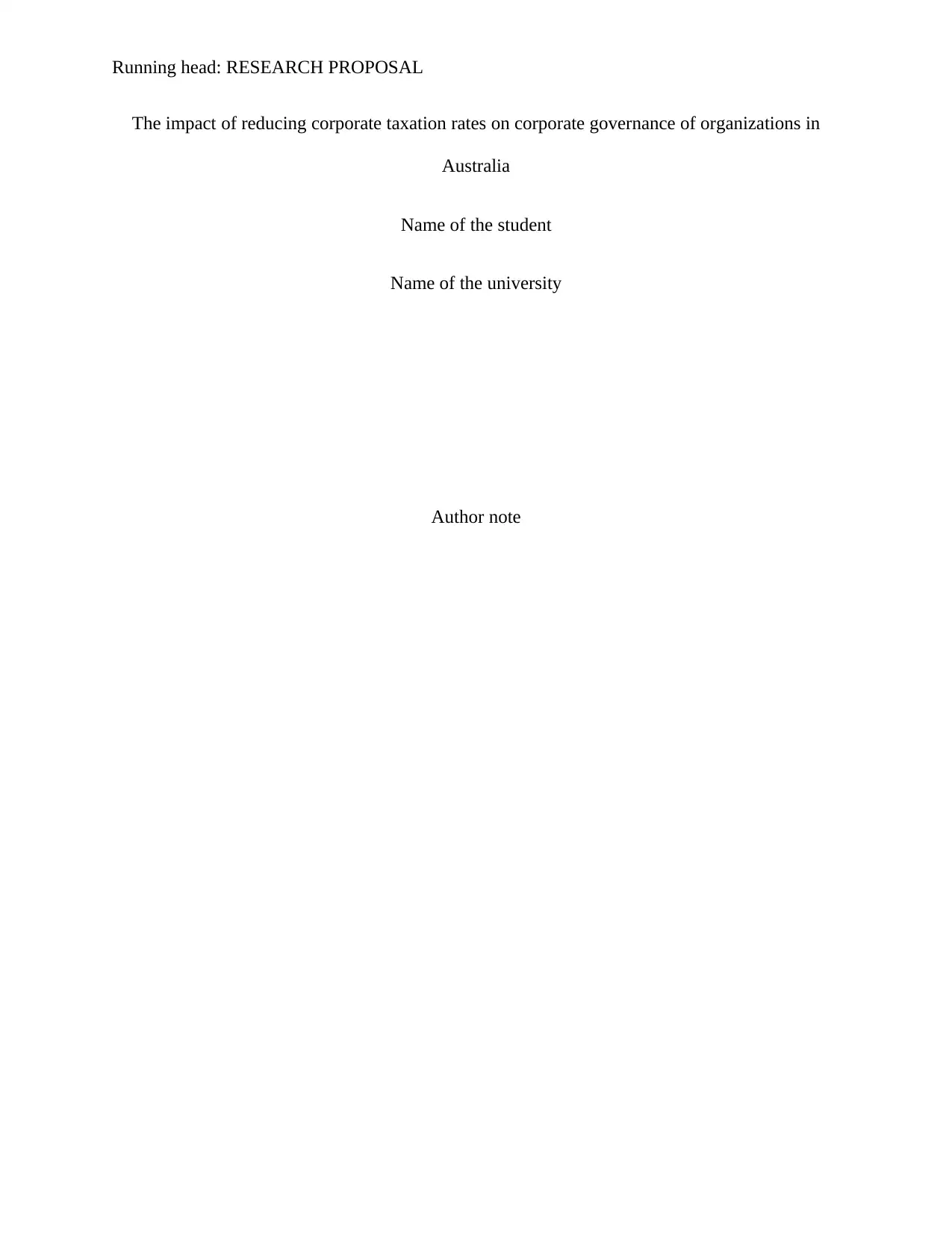
Running head: RESEARCH PROPOSAL
The impact of reducing corporate taxation rates on corporate governance of organizations in
Australia
Name of the student
Name of the university
Author note
The impact of reducing corporate taxation rates on corporate governance of organizations in
Australia
Name of the student
Name of the university
Author note
Paraphrase This Document
Need a fresh take? Get an instant paraphrase of this document with our AI Paraphraser
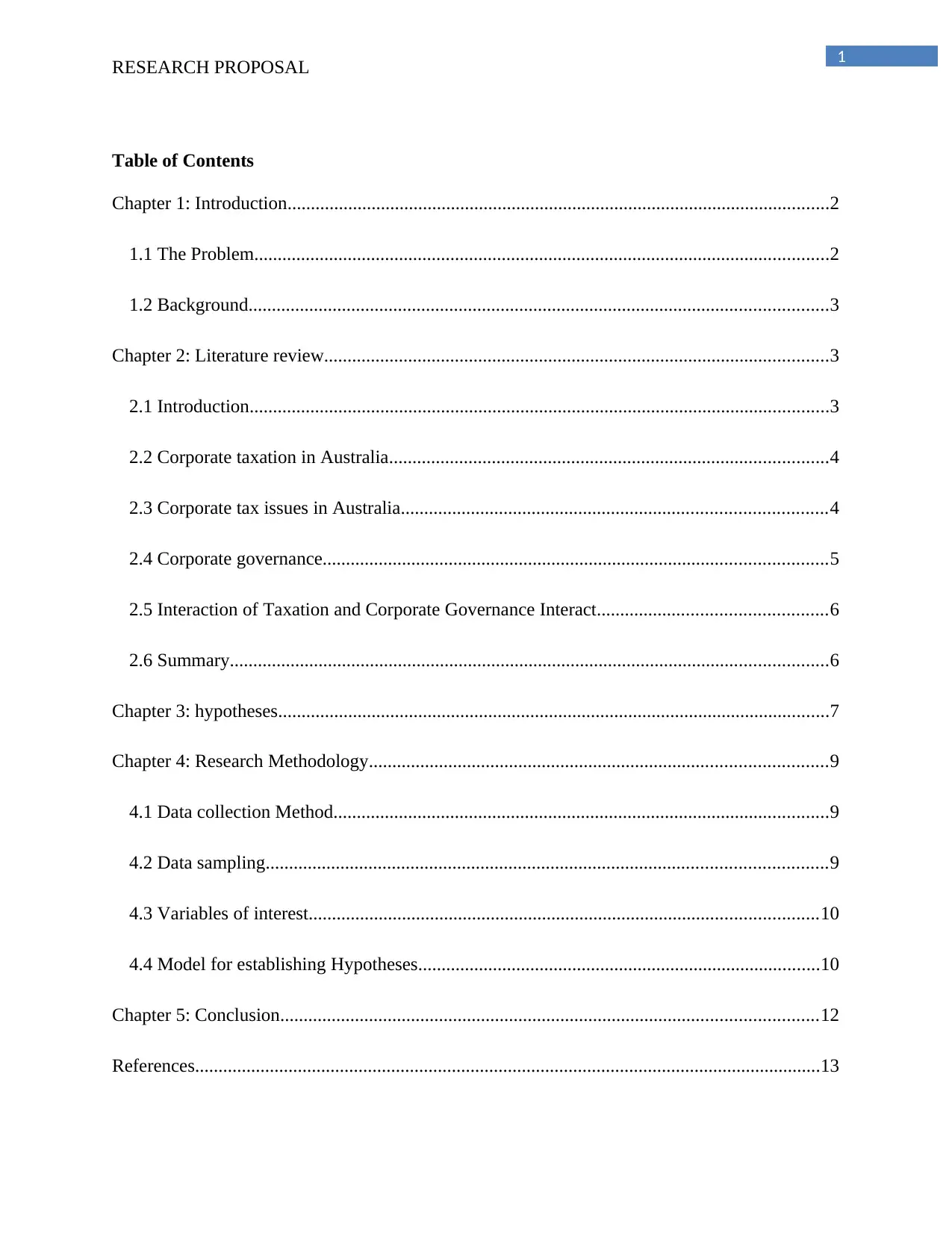
1
RESEARCH PROPOSAL
Table of Contents
Chapter 1: Introduction....................................................................................................................2
1.1 The Problem...........................................................................................................................2
1.2 Background............................................................................................................................3
Chapter 2: Literature review............................................................................................................3
2.1 Introduction............................................................................................................................3
2.2 Corporate taxation in Australia..............................................................................................4
2.3 Corporate tax issues in Australia...........................................................................................4
2.4 Corporate governance............................................................................................................5
2.5 Interaction of Taxation and Corporate Governance Interact.................................................6
2.6 Summary................................................................................................................................6
Chapter 3: hypotheses......................................................................................................................7
Chapter 4: Research Methodology..................................................................................................9
4.1 Data collection Method..........................................................................................................9
4.2 Data sampling........................................................................................................................9
4.3 Variables of interest.............................................................................................................10
4.4 Model for establishing Hypotheses......................................................................................10
Chapter 5: Conclusion...................................................................................................................12
References......................................................................................................................................13
RESEARCH PROPOSAL
Table of Contents
Chapter 1: Introduction....................................................................................................................2
1.1 The Problem...........................................................................................................................2
1.2 Background............................................................................................................................3
Chapter 2: Literature review............................................................................................................3
2.1 Introduction............................................................................................................................3
2.2 Corporate taxation in Australia..............................................................................................4
2.3 Corporate tax issues in Australia...........................................................................................4
2.4 Corporate governance............................................................................................................5
2.5 Interaction of Taxation and Corporate Governance Interact.................................................6
2.6 Summary................................................................................................................................6
Chapter 3: hypotheses......................................................................................................................7
Chapter 4: Research Methodology..................................................................................................9
4.1 Data collection Method..........................................................................................................9
4.2 Data sampling........................................................................................................................9
4.3 Variables of interest.............................................................................................................10
4.4 Model for establishing Hypotheses......................................................................................10
Chapter 5: Conclusion...................................................................................................................12
References......................................................................................................................................13

2
RESEARCH PROPOSAL
RESEARCH PROPOSAL
You're viewing a preview
Unlock full access by subscribing today!
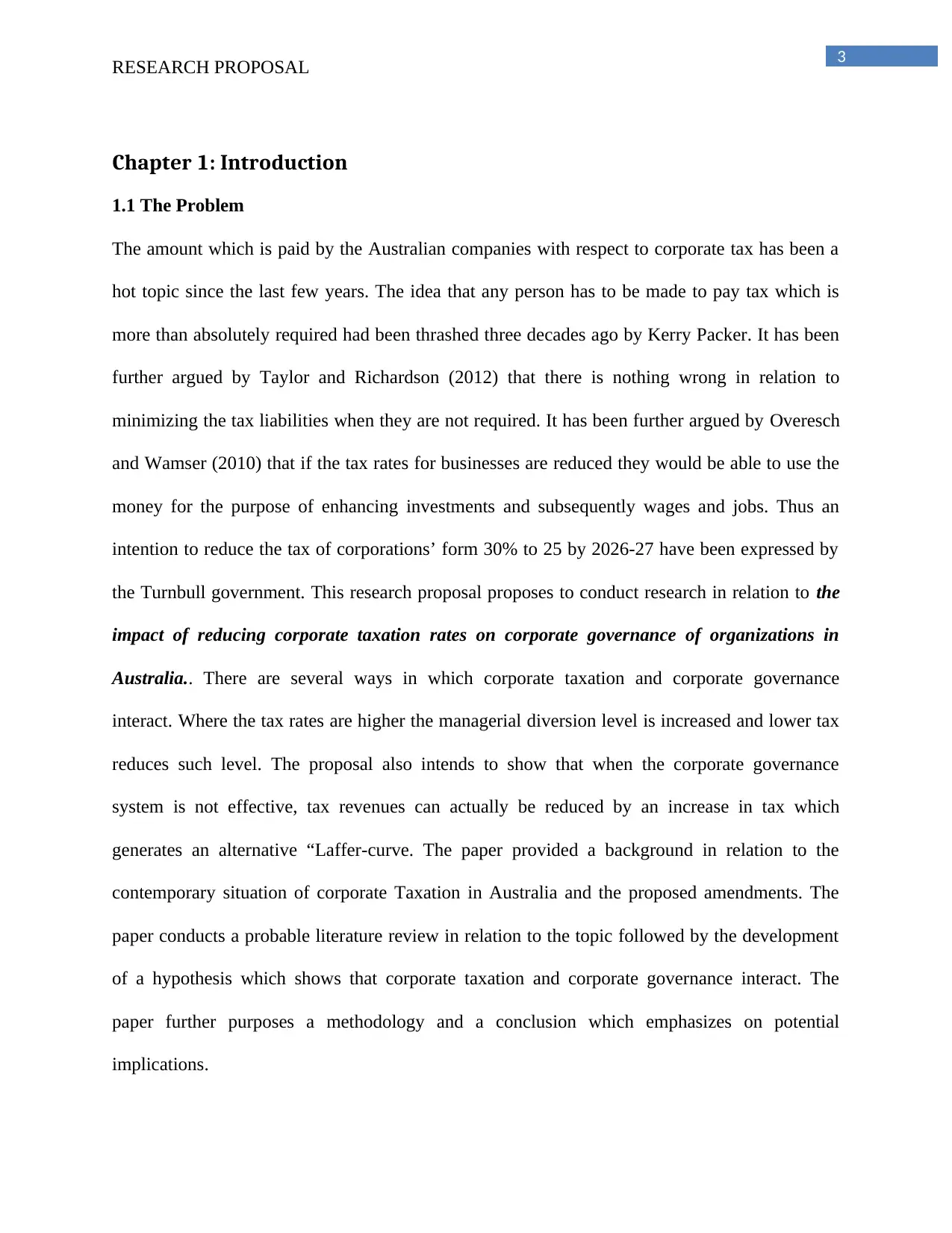
3
RESEARCH PROPOSAL
Chapter 1: Introduction
1.1 The Problem
The amount which is paid by the Australian companies with respect to corporate tax has been a
hot topic since the last few years. The idea that any person has to be made to pay tax which is
more than absolutely required had been thrashed three decades ago by Kerry Packer. It has been
further argued by Taylor and Richardson (2012) that there is nothing wrong in relation to
minimizing the tax liabilities when they are not required. It has been further argued by Overesch
and Wamser (2010) that if the tax rates for businesses are reduced they would be able to use the
money for the purpose of enhancing investments and subsequently wages and jobs. Thus an
intention to reduce the tax of corporations’ form 30% to 25 by 2026-27 have been expressed by
the Turnbull government. This research proposal proposes to conduct research in relation to the
impact of reducing corporate taxation rates on corporate governance of organizations in
Australia.. There are several ways in which corporate taxation and corporate governance
interact. Where the tax rates are higher the managerial diversion level is increased and lower tax
reduces such level. The proposal also intends to show that when the corporate governance
system is not effective, tax revenues can actually be reduced by an increase in tax which
generates an alternative “Laffer-curve. The paper provided a background in relation to the
contemporary situation of corporate Taxation in Australia and the proposed amendments. The
paper conducts a probable literature review in relation to the topic followed by the development
of a hypothesis which shows that corporate taxation and corporate governance interact. The
paper further purposes a methodology and a conclusion which emphasizes on potential
implications.
RESEARCH PROPOSAL
Chapter 1: Introduction
1.1 The Problem
The amount which is paid by the Australian companies with respect to corporate tax has been a
hot topic since the last few years. The idea that any person has to be made to pay tax which is
more than absolutely required had been thrashed three decades ago by Kerry Packer. It has been
further argued by Taylor and Richardson (2012) that there is nothing wrong in relation to
minimizing the tax liabilities when they are not required. It has been further argued by Overesch
and Wamser (2010) that if the tax rates for businesses are reduced they would be able to use the
money for the purpose of enhancing investments and subsequently wages and jobs. Thus an
intention to reduce the tax of corporations’ form 30% to 25 by 2026-27 have been expressed by
the Turnbull government. This research proposal proposes to conduct research in relation to the
impact of reducing corporate taxation rates on corporate governance of organizations in
Australia.. There are several ways in which corporate taxation and corporate governance
interact. Where the tax rates are higher the managerial diversion level is increased and lower tax
reduces such level. The proposal also intends to show that when the corporate governance
system is not effective, tax revenues can actually be reduced by an increase in tax which
generates an alternative “Laffer-curve. The paper provided a background in relation to the
contemporary situation of corporate Taxation in Australia and the proposed amendments. The
paper conducts a probable literature review in relation to the topic followed by the development
of a hypothesis which shows that corporate taxation and corporate governance interact. The
paper further purposes a methodology and a conclusion which emphasizes on potential
implications.
Paraphrase This Document
Need a fresh take? Get an instant paraphrase of this document with our AI Paraphraser
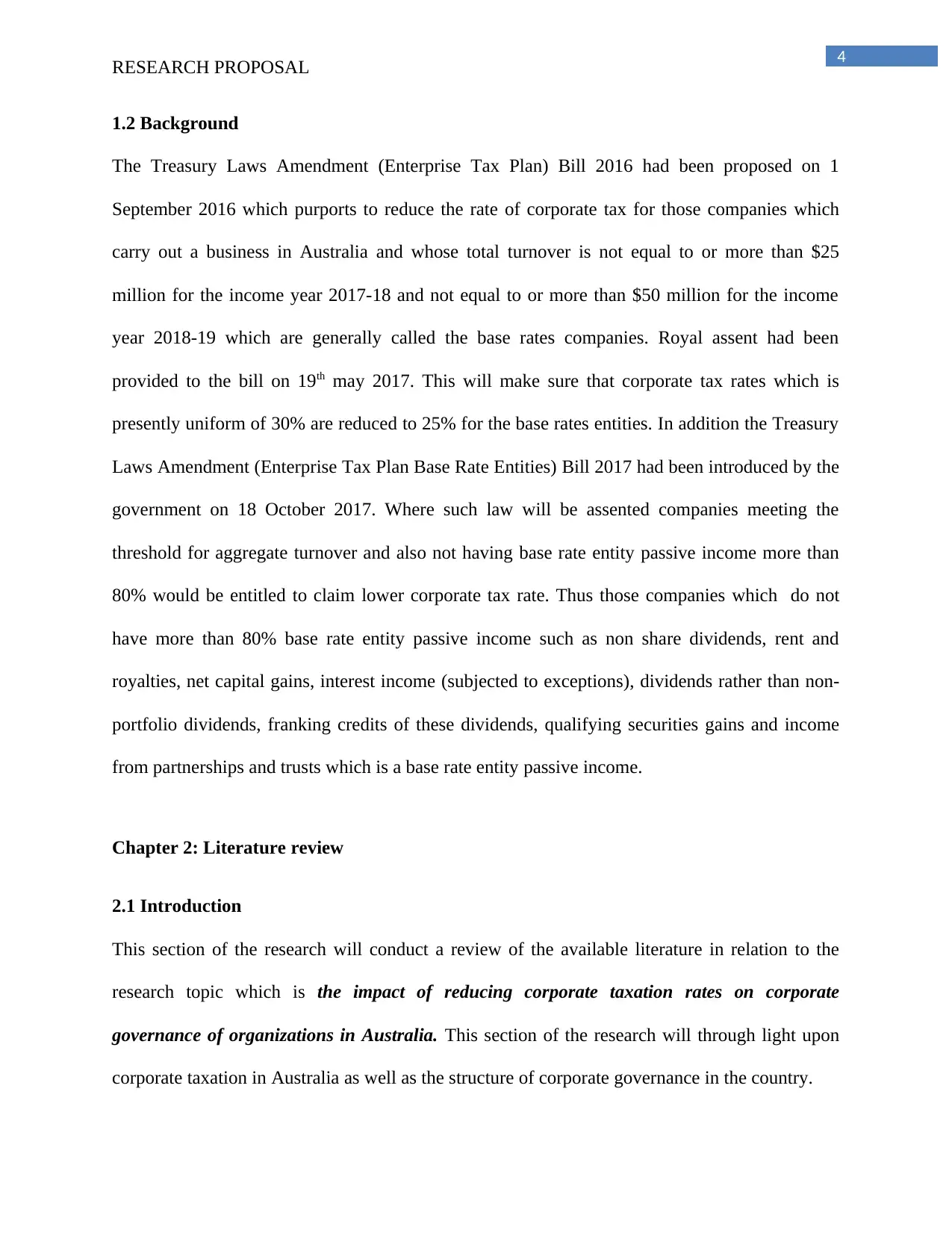
4
RESEARCH PROPOSAL
1.2 Background
The Treasury Laws Amendment (Enterprise Tax Plan) Bill 2016 had been proposed on 1
September 2016 which purports to reduce the rate of corporate tax for those companies which
carry out a business in Australia and whose total turnover is not equal to or more than $25
million for the income year 2017-18 and not equal to or more than $50 million for the income
year 2018-19 which are generally called the base rates companies. Royal assent had been
provided to the bill on 19th may 2017. This will make sure that corporate tax rates which is
presently uniform of 30% are reduced to 25% for the base rates entities. In addition the Treasury
Laws Amendment (Enterprise Tax Plan Base Rate Entities) Bill 2017 had been introduced by the
government on 18 October 2017. Where such law will be assented companies meeting the
threshold for aggregate turnover and also not having base rate entity passive income more than
80% would be entitled to claim lower corporate tax rate. Thus those companies which do not
have more than 80% base rate entity passive income such as non share dividends, rent and
royalties, net capital gains, interest income (subjected to exceptions), dividends rather than non-
portfolio dividends, franking credits of these dividends, qualifying securities gains and income
from partnerships and trusts which is a base rate entity passive income.
Chapter 2: Literature review
2.1 Introduction
This section of the research will conduct a review of the available literature in relation to the
research topic which is the impact of reducing corporate taxation rates on corporate
governance of organizations in Australia. This section of the research will through light upon
corporate taxation in Australia as well as the structure of corporate governance in the country.
RESEARCH PROPOSAL
1.2 Background
The Treasury Laws Amendment (Enterprise Tax Plan) Bill 2016 had been proposed on 1
September 2016 which purports to reduce the rate of corporate tax for those companies which
carry out a business in Australia and whose total turnover is not equal to or more than $25
million for the income year 2017-18 and not equal to or more than $50 million for the income
year 2018-19 which are generally called the base rates companies. Royal assent had been
provided to the bill on 19th may 2017. This will make sure that corporate tax rates which is
presently uniform of 30% are reduced to 25% for the base rates entities. In addition the Treasury
Laws Amendment (Enterprise Tax Plan Base Rate Entities) Bill 2017 had been introduced by the
government on 18 October 2017. Where such law will be assented companies meeting the
threshold for aggregate turnover and also not having base rate entity passive income more than
80% would be entitled to claim lower corporate tax rate. Thus those companies which do not
have more than 80% base rate entity passive income such as non share dividends, rent and
royalties, net capital gains, interest income (subjected to exceptions), dividends rather than non-
portfolio dividends, franking credits of these dividends, qualifying securities gains and income
from partnerships and trusts which is a base rate entity passive income.
Chapter 2: Literature review
2.1 Introduction
This section of the research will conduct a review of the available literature in relation to the
research topic which is the impact of reducing corporate taxation rates on corporate
governance of organizations in Australia. This section of the research will through light upon
corporate taxation in Australia as well as the structure of corporate governance in the country.
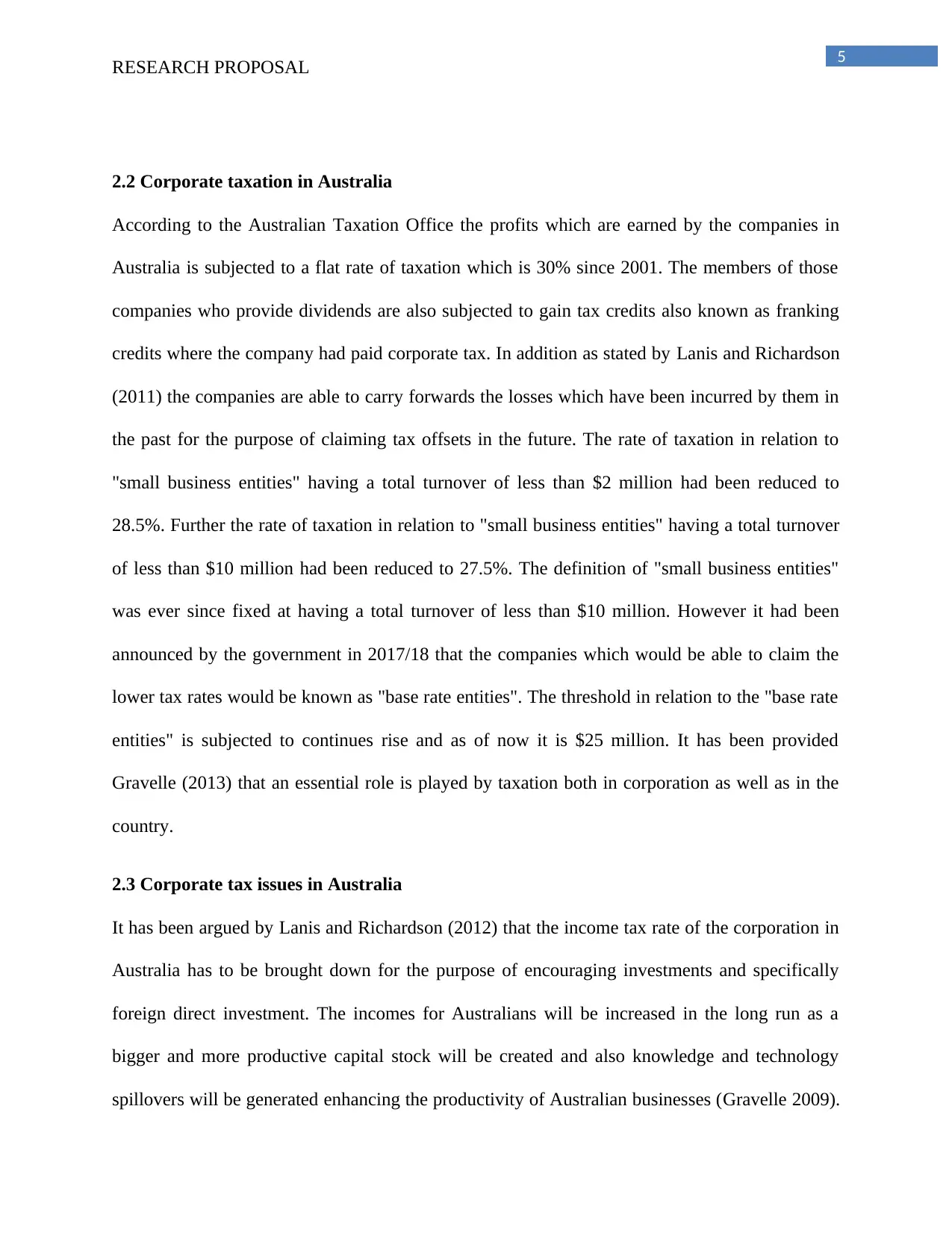
5
RESEARCH PROPOSAL
2.2 Corporate taxation in Australia
According to the Australian Taxation Office the profits which are earned by the companies in
Australia is subjected to a flat rate of taxation which is 30% since 2001. The members of those
companies who provide dividends are also subjected to gain tax credits also known as franking
credits where the company had paid corporate tax. In addition as stated by Lanis and Richardson
(2011) the companies are able to carry forwards the losses which have been incurred by them in
the past for the purpose of claiming tax offsets in the future. The rate of taxation in relation to
"small business entities" having a total turnover of less than $2 million had been reduced to
28.5%. Further the rate of taxation in relation to "small business entities" having a total turnover
of less than $10 million had been reduced to 27.5%. The definition of "small business entities"
was ever since fixed at having a total turnover of less than $10 million. However it had been
announced by the government in 2017/18 that the companies which would be able to claim the
lower tax rates would be known as "base rate entities". The threshold in relation to the "base rate
entities" is subjected to continues rise and as of now it is $25 million. It has been provided
Gravelle (2013) that an essential role is played by taxation both in corporation as well as in the
country.
2.3 Corporate tax issues in Australia
It has been argued by Lanis and Richardson (2012) that the income tax rate of the corporation in
Australia has to be brought down for the purpose of encouraging investments and specifically
foreign direct investment. The incomes for Australians will be increased in the long run as a
bigger and more productive capital stock will be created and also knowledge and technology
spillovers will be generated enhancing the productivity of Australian businesses (Gravelle 2009).
RESEARCH PROPOSAL
2.2 Corporate taxation in Australia
According to the Australian Taxation Office the profits which are earned by the companies in
Australia is subjected to a flat rate of taxation which is 30% since 2001. The members of those
companies who provide dividends are also subjected to gain tax credits also known as franking
credits where the company had paid corporate tax. In addition as stated by Lanis and Richardson
(2011) the companies are able to carry forwards the losses which have been incurred by them in
the past for the purpose of claiming tax offsets in the future. The rate of taxation in relation to
"small business entities" having a total turnover of less than $2 million had been reduced to
28.5%. Further the rate of taxation in relation to "small business entities" having a total turnover
of less than $10 million had been reduced to 27.5%. The definition of "small business entities"
was ever since fixed at having a total turnover of less than $10 million. However it had been
announced by the government in 2017/18 that the companies which would be able to claim the
lower tax rates would be known as "base rate entities". The threshold in relation to the "base rate
entities" is subjected to continues rise and as of now it is $25 million. It has been provided
Gravelle (2013) that an essential role is played by taxation both in corporation as well as in the
country.
2.3 Corporate tax issues in Australia
It has been argued by Lanis and Richardson (2012) that the income tax rate of the corporation in
Australia has to be brought down for the purpose of encouraging investments and specifically
foreign direct investment. The incomes for Australians will be increased in the long run as a
bigger and more productive capital stock will be created and also knowledge and technology
spillovers will be generated enhancing the productivity of Australian businesses (Gravelle 2009).
You're viewing a preview
Unlock full access by subscribing today!
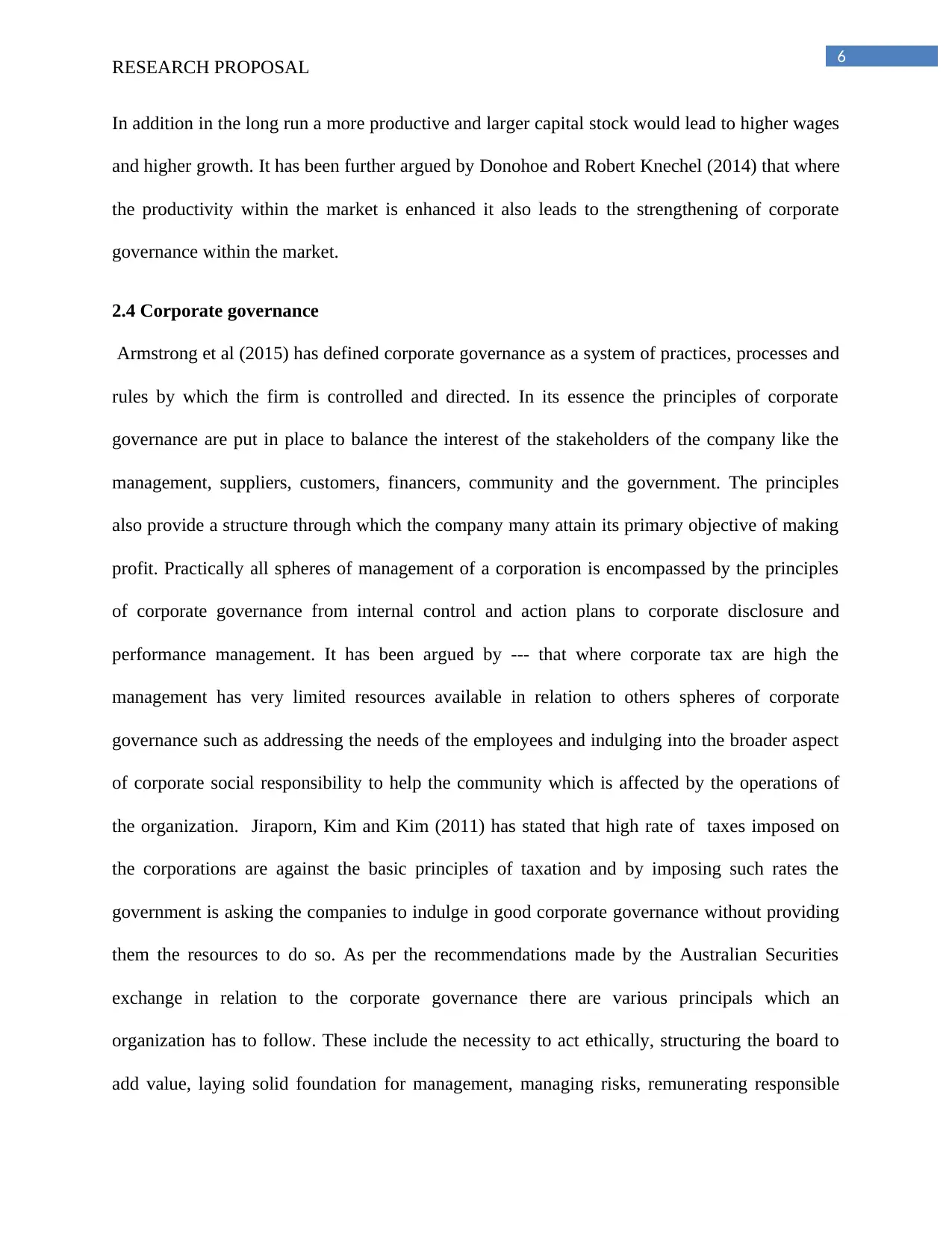
6
RESEARCH PROPOSAL
In addition in the long run a more productive and larger capital stock would lead to higher wages
and higher growth. It has been further argued by Donohoe and Robert Knechel (2014) that where
the productivity within the market is enhanced it also leads to the strengthening of corporate
governance within the market.
2.4 Corporate governance
Armstrong et al (2015) has defined corporate governance as a system of practices, processes and
rules by which the firm is controlled and directed. In its essence the principles of corporate
governance are put in place to balance the interest of the stakeholders of the company like the
management, suppliers, customers, financers, community and the government. The principles
also provide a structure through which the company many attain its primary objective of making
profit. Practically all spheres of management of a corporation is encompassed by the principles
of corporate governance from internal control and action plans to corporate disclosure and
performance management. It has been argued by --- that where corporate tax are high the
management has very limited resources available in relation to others spheres of corporate
governance such as addressing the needs of the employees and indulging into the broader aspect
of corporate social responsibility to help the community which is affected by the operations of
the organization. Jiraporn, Kim and Kim (2011) has stated that high rate of taxes imposed on
the corporations are against the basic principles of taxation and by imposing such rates the
government is asking the companies to indulge in good corporate governance without providing
them the resources to do so. As per the recommendations made by the Australian Securities
exchange in relation to the corporate governance there are various principals which an
organization has to follow. These include the necessity to act ethically, structuring the board to
add value, laying solid foundation for management, managing risks, remunerating responsible
RESEARCH PROPOSAL
In addition in the long run a more productive and larger capital stock would lead to higher wages
and higher growth. It has been further argued by Donohoe and Robert Knechel (2014) that where
the productivity within the market is enhanced it also leads to the strengthening of corporate
governance within the market.
2.4 Corporate governance
Armstrong et al (2015) has defined corporate governance as a system of practices, processes and
rules by which the firm is controlled and directed. In its essence the principles of corporate
governance are put in place to balance the interest of the stakeholders of the company like the
management, suppliers, customers, financers, community and the government. The principles
also provide a structure through which the company many attain its primary objective of making
profit. Practically all spheres of management of a corporation is encompassed by the principles
of corporate governance from internal control and action plans to corporate disclosure and
performance management. It has been argued by --- that where corporate tax are high the
management has very limited resources available in relation to others spheres of corporate
governance such as addressing the needs of the employees and indulging into the broader aspect
of corporate social responsibility to help the community which is affected by the operations of
the organization. Jiraporn, Kim and Kim (2011) has stated that high rate of taxes imposed on
the corporations are against the basic principles of taxation and by imposing such rates the
government is asking the companies to indulge in good corporate governance without providing
them the resources to do so. As per the recommendations made by the Australian Securities
exchange in relation to the corporate governance there are various principals which an
organization has to follow. These include the necessity to act ethically, structuring the board to
add value, laying solid foundation for management, managing risks, remunerating responsible
Paraphrase This Document
Need a fresh take? Get an instant paraphrase of this document with our AI Paraphraser
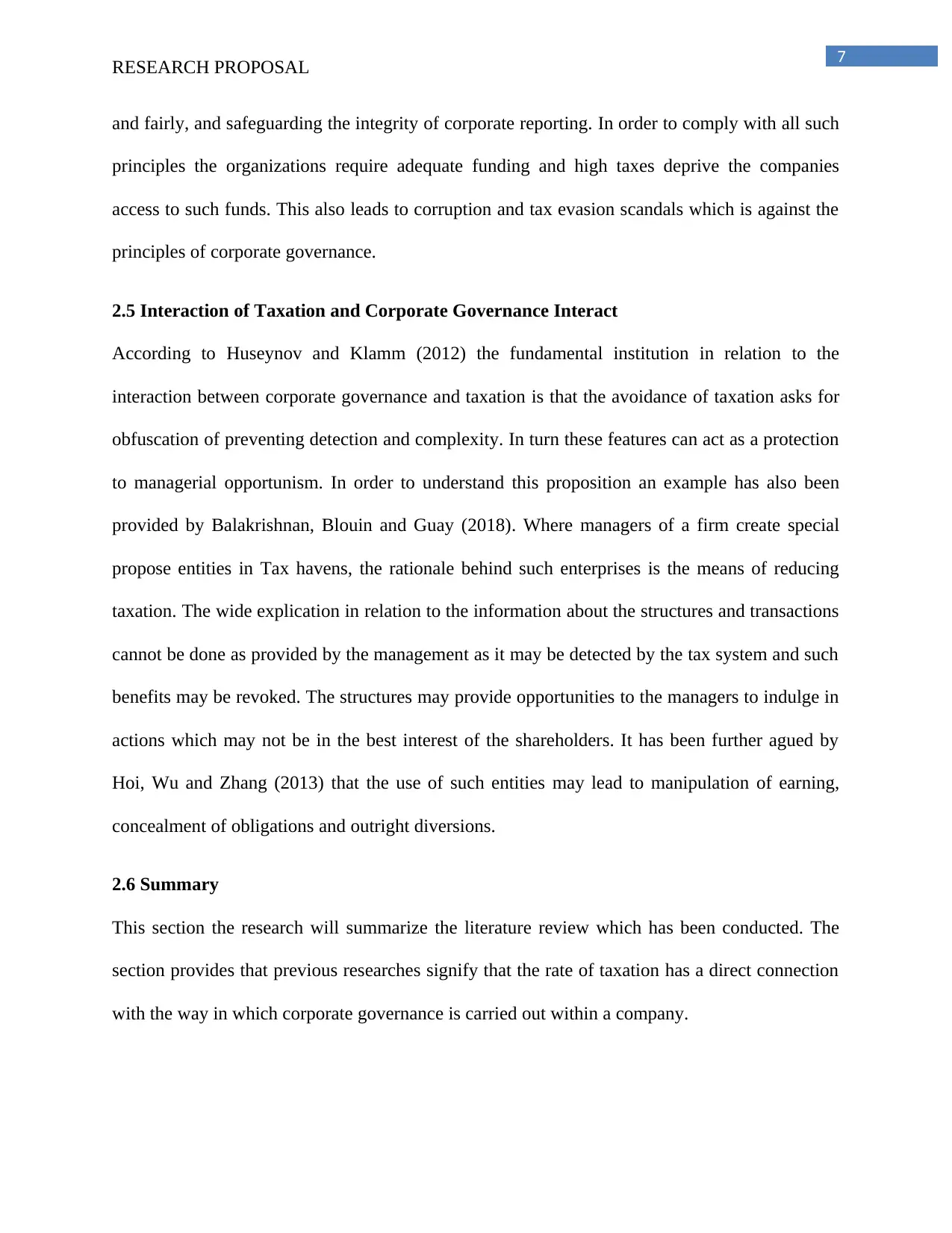
7
RESEARCH PROPOSAL
and fairly, and safeguarding the integrity of corporate reporting. In order to comply with all such
principles the organizations require adequate funding and high taxes deprive the companies
access to such funds. This also leads to corruption and tax evasion scandals which is against the
principles of corporate governance.
2.5 Interaction of Taxation and Corporate Governance Interact
According to Huseynov and Klamm (2012) the fundamental institution in relation to the
interaction between corporate governance and taxation is that the avoidance of taxation asks for
obfuscation of preventing detection and complexity. In turn these features can act as a protection
to managerial opportunism. In order to understand this proposition an example has also been
provided by Balakrishnan, Blouin and Guay (2018). Where managers of a firm create special
propose entities in Tax havens, the rationale behind such enterprises is the means of reducing
taxation. The wide explication in relation to the information about the structures and transactions
cannot be done as provided by the management as it may be detected by the tax system and such
benefits may be revoked. The structures may provide opportunities to the managers to indulge in
actions which may not be in the best interest of the shareholders. It has been further agued by
Hoi, Wu and Zhang (2013) that the use of such entities may lead to manipulation of earning,
concealment of obligations and outright diversions.
2.6 Summary
This section the research will summarize the literature review which has been conducted. The
section provides that previous researches signify that the rate of taxation has a direct connection
with the way in which corporate governance is carried out within a company.
RESEARCH PROPOSAL
and fairly, and safeguarding the integrity of corporate reporting. In order to comply with all such
principles the organizations require adequate funding and high taxes deprive the companies
access to such funds. This also leads to corruption and tax evasion scandals which is against the
principles of corporate governance.
2.5 Interaction of Taxation and Corporate Governance Interact
According to Huseynov and Klamm (2012) the fundamental institution in relation to the
interaction between corporate governance and taxation is that the avoidance of taxation asks for
obfuscation of preventing detection and complexity. In turn these features can act as a protection
to managerial opportunism. In order to understand this proposition an example has also been
provided by Balakrishnan, Blouin and Guay (2018). Where managers of a firm create special
propose entities in Tax havens, the rationale behind such enterprises is the means of reducing
taxation. The wide explication in relation to the information about the structures and transactions
cannot be done as provided by the management as it may be detected by the tax system and such
benefits may be revoked. The structures may provide opportunities to the managers to indulge in
actions which may not be in the best interest of the shareholders. It has been further agued by
Hoi, Wu and Zhang (2013) that the use of such entities may lead to manipulation of earning,
concealment of obligations and outright diversions.
2.6 Summary
This section the research will summarize the literature review which has been conducted. The
section provides that previous researches signify that the rate of taxation has a direct connection
with the way in which corporate governance is carried out within a company.
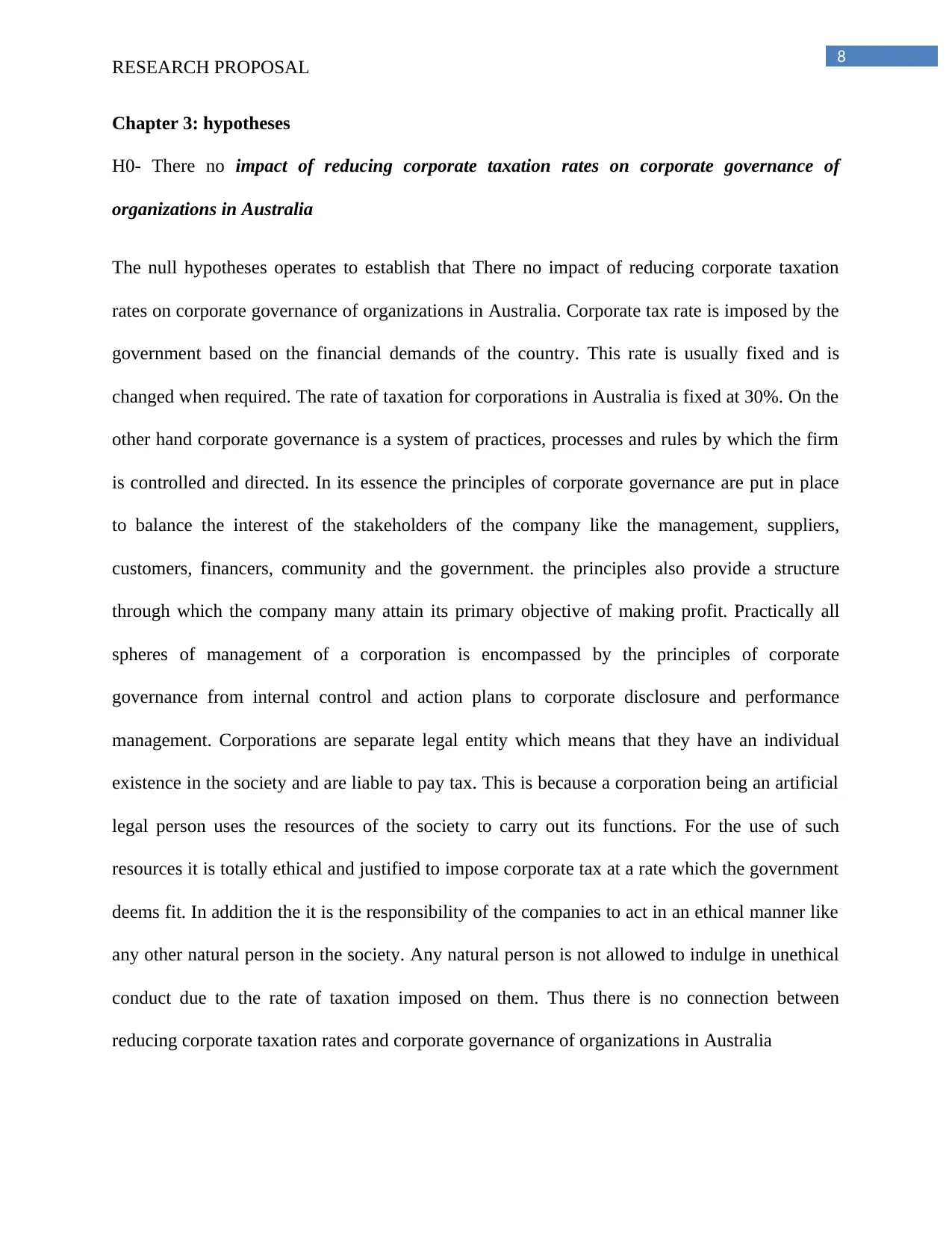
8
RESEARCH PROPOSAL
Chapter 3: hypotheses
H0- There no impact of reducing corporate taxation rates on corporate governance of
organizations in Australia
The null hypotheses operates to establish that There no impact of reducing corporate taxation
rates on corporate governance of organizations in Australia. Corporate tax rate is imposed by the
government based on the financial demands of the country. This rate is usually fixed and is
changed when required. The rate of taxation for corporations in Australia is fixed at 30%. On the
other hand corporate governance is a system of practices, processes and rules by which the firm
is controlled and directed. In its essence the principles of corporate governance are put in place
to balance the interest of the stakeholders of the company like the management, suppliers,
customers, financers, community and the government. the principles also provide a structure
through which the company many attain its primary objective of making profit. Practically all
spheres of management of a corporation is encompassed by the principles of corporate
governance from internal control and action plans to corporate disclosure and performance
management. Corporations are separate legal entity which means that they have an individual
existence in the society and are liable to pay tax. This is because a corporation being an artificial
legal person uses the resources of the society to carry out its functions. For the use of such
resources it is totally ethical and justified to impose corporate tax at a rate which the government
deems fit. In addition the it is the responsibility of the companies to act in an ethical manner like
any other natural person in the society. Any natural person is not allowed to indulge in unethical
conduct due to the rate of taxation imposed on them. Thus there is no connection between
reducing corporate taxation rates and corporate governance of organizations in Australia
RESEARCH PROPOSAL
Chapter 3: hypotheses
H0- There no impact of reducing corporate taxation rates on corporate governance of
organizations in Australia
The null hypotheses operates to establish that There no impact of reducing corporate taxation
rates on corporate governance of organizations in Australia. Corporate tax rate is imposed by the
government based on the financial demands of the country. This rate is usually fixed and is
changed when required. The rate of taxation for corporations in Australia is fixed at 30%. On the
other hand corporate governance is a system of practices, processes and rules by which the firm
is controlled and directed. In its essence the principles of corporate governance are put in place
to balance the interest of the stakeholders of the company like the management, suppliers,
customers, financers, community and the government. the principles also provide a structure
through which the company many attain its primary objective of making profit. Practically all
spheres of management of a corporation is encompassed by the principles of corporate
governance from internal control and action plans to corporate disclosure and performance
management. Corporations are separate legal entity which means that they have an individual
existence in the society and are liable to pay tax. This is because a corporation being an artificial
legal person uses the resources of the society to carry out its functions. For the use of such
resources it is totally ethical and justified to impose corporate tax at a rate which the government
deems fit. In addition the it is the responsibility of the companies to act in an ethical manner like
any other natural person in the society. Any natural person is not allowed to indulge in unethical
conduct due to the rate of taxation imposed on them. Thus there is no connection between
reducing corporate taxation rates and corporate governance of organizations in Australia
You're viewing a preview
Unlock full access by subscribing today!
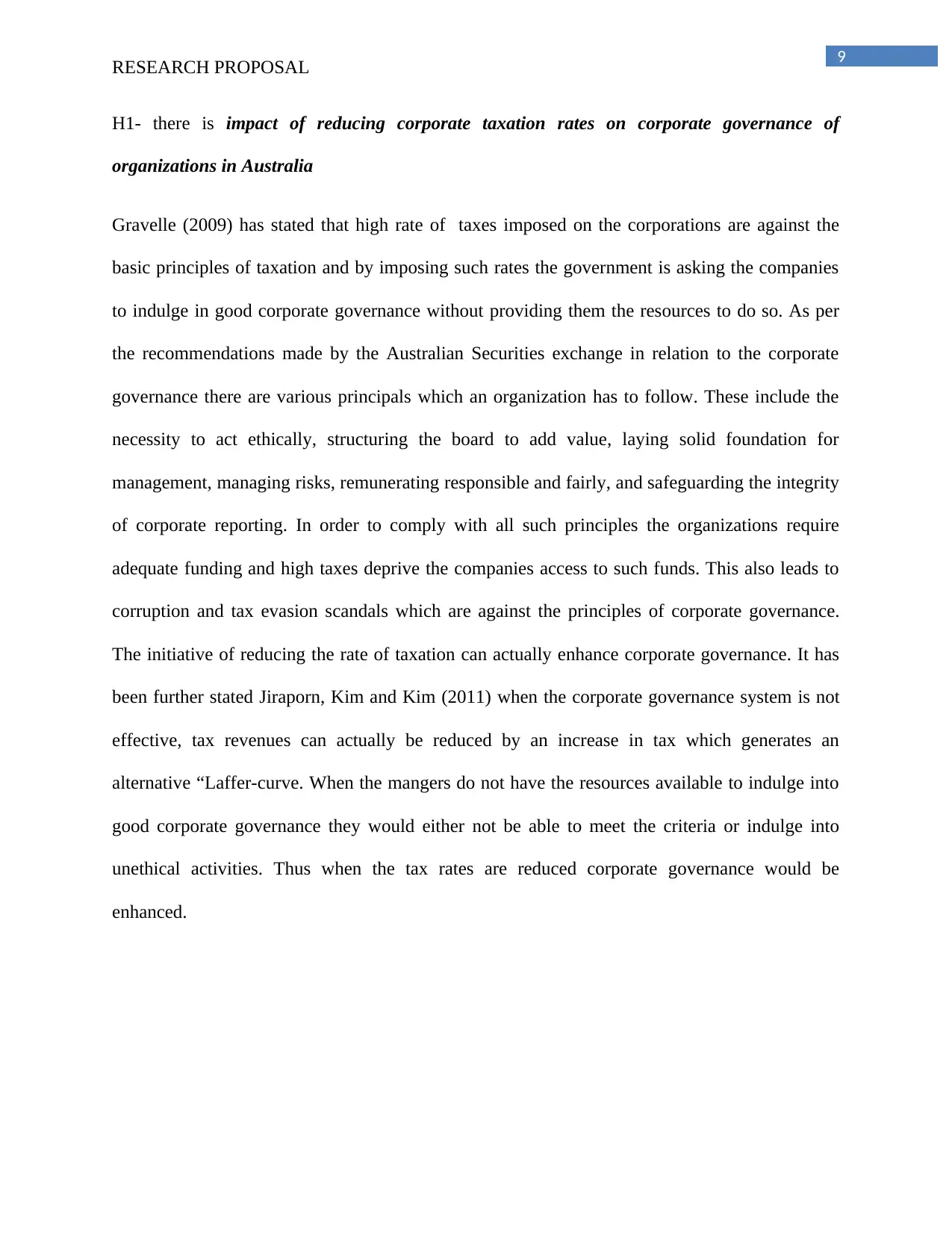
9
RESEARCH PROPOSAL
H1- there is impact of reducing corporate taxation rates on corporate governance of
organizations in Australia
Gravelle (2009) has stated that high rate of taxes imposed on the corporations are against the
basic principles of taxation and by imposing such rates the government is asking the companies
to indulge in good corporate governance without providing them the resources to do so. As per
the recommendations made by the Australian Securities exchange in relation to the corporate
governance there are various principals which an organization has to follow. These include the
necessity to act ethically, structuring the board to add value, laying solid foundation for
management, managing risks, remunerating responsible and fairly, and safeguarding the integrity
of corporate reporting. In order to comply with all such principles the organizations require
adequate funding and high taxes deprive the companies access to such funds. This also leads to
corruption and tax evasion scandals which are against the principles of corporate governance.
The initiative of reducing the rate of taxation can actually enhance corporate governance. It has
been further stated Jiraporn, Kim and Kim (2011) when the corporate governance system is not
effective, tax revenues can actually be reduced by an increase in tax which generates an
alternative “Laffer-curve. When the mangers do not have the resources available to indulge into
good corporate governance they would either not be able to meet the criteria or indulge into
unethical activities. Thus when the tax rates are reduced corporate governance would be
enhanced.
RESEARCH PROPOSAL
H1- there is impact of reducing corporate taxation rates on corporate governance of
organizations in Australia
Gravelle (2009) has stated that high rate of taxes imposed on the corporations are against the
basic principles of taxation and by imposing such rates the government is asking the companies
to indulge in good corporate governance without providing them the resources to do so. As per
the recommendations made by the Australian Securities exchange in relation to the corporate
governance there are various principals which an organization has to follow. These include the
necessity to act ethically, structuring the board to add value, laying solid foundation for
management, managing risks, remunerating responsible and fairly, and safeguarding the integrity
of corporate reporting. In order to comply with all such principles the organizations require
adequate funding and high taxes deprive the companies access to such funds. This also leads to
corruption and tax evasion scandals which are against the principles of corporate governance.
The initiative of reducing the rate of taxation can actually enhance corporate governance. It has
been further stated Jiraporn, Kim and Kim (2011) when the corporate governance system is not
effective, tax revenues can actually be reduced by an increase in tax which generates an
alternative “Laffer-curve. When the mangers do not have the resources available to indulge into
good corporate governance they would either not be able to meet the criteria or indulge into
unethical activities. Thus when the tax rates are reduced corporate governance would be
enhanced.
Paraphrase This Document
Need a fresh take? Get an instant paraphrase of this document with our AI Paraphraser
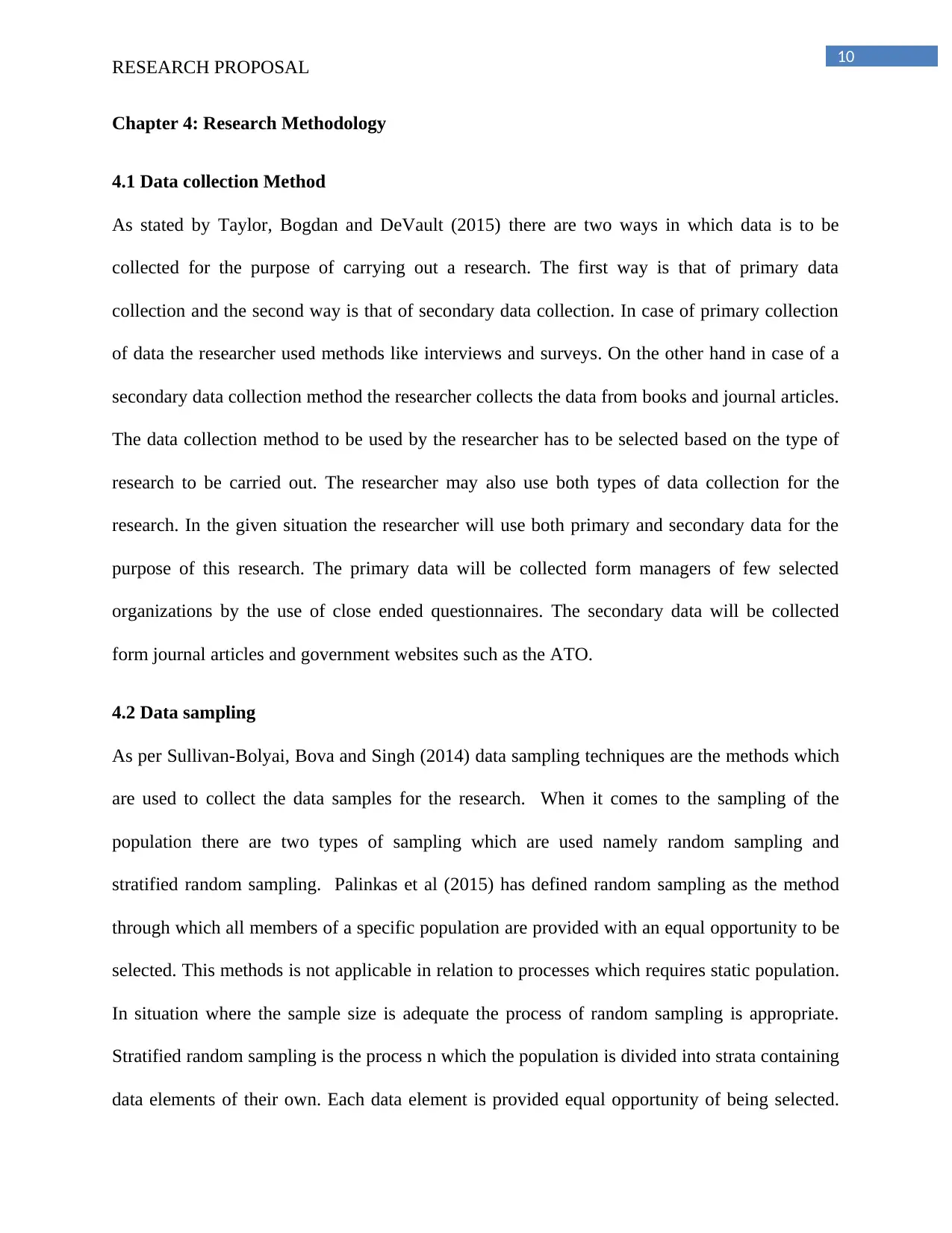
10
RESEARCH PROPOSAL
Chapter 4: Research Methodology
4.1 Data collection Method
As stated by Taylor, Bogdan and DeVault (2015) there are two ways in which data is to be
collected for the purpose of carrying out a research. The first way is that of primary data
collection and the second way is that of secondary data collection. In case of primary collection
of data the researcher used methods like interviews and surveys. On the other hand in case of a
secondary data collection method the researcher collects the data from books and journal articles.
The data collection method to be used by the researcher has to be selected based on the type of
research to be carried out. The researcher may also use both types of data collection for the
research. In the given situation the researcher will use both primary and secondary data for the
purpose of this research. The primary data will be collected form managers of few selected
organizations by the use of close ended questionnaires. The secondary data will be collected
form journal articles and government websites such as the ATO.
4.2 Data sampling
As per Sullivan-Bolyai, Bova and Singh (2014) data sampling techniques are the methods which
are used to collect the data samples for the research. When it comes to the sampling of the
population there are two types of sampling which are used namely random sampling and
stratified random sampling. Palinkas et al (2015) has defined random sampling as the method
through which all members of a specific population are provided with an equal opportunity to be
selected. This methods is not applicable in relation to processes which requires static population.
In situation where the sample size is adequate the process of random sampling is appropriate.
Stratified random sampling is the process n which the population is divided into strata containing
data elements of their own. Each data element is provided equal opportunity of being selected.
RESEARCH PROPOSAL
Chapter 4: Research Methodology
4.1 Data collection Method
As stated by Taylor, Bogdan and DeVault (2015) there are two ways in which data is to be
collected for the purpose of carrying out a research. The first way is that of primary data
collection and the second way is that of secondary data collection. In case of primary collection
of data the researcher used methods like interviews and surveys. On the other hand in case of a
secondary data collection method the researcher collects the data from books and journal articles.
The data collection method to be used by the researcher has to be selected based on the type of
research to be carried out. The researcher may also use both types of data collection for the
research. In the given situation the researcher will use both primary and secondary data for the
purpose of this research. The primary data will be collected form managers of few selected
organizations by the use of close ended questionnaires. The secondary data will be collected
form journal articles and government websites such as the ATO.
4.2 Data sampling
As per Sullivan-Bolyai, Bova and Singh (2014) data sampling techniques are the methods which
are used to collect the data samples for the research. When it comes to the sampling of the
population there are two types of sampling which are used namely random sampling and
stratified random sampling. Palinkas et al (2015) has defined random sampling as the method
through which all members of a specific population are provided with an equal opportunity to be
selected. This methods is not applicable in relation to processes which requires static population.
In situation where the sample size is adequate the process of random sampling is appropriate.
Stratified random sampling is the process n which the population is divided into strata containing
data elements of their own. Each data element is provided equal opportunity of being selected.
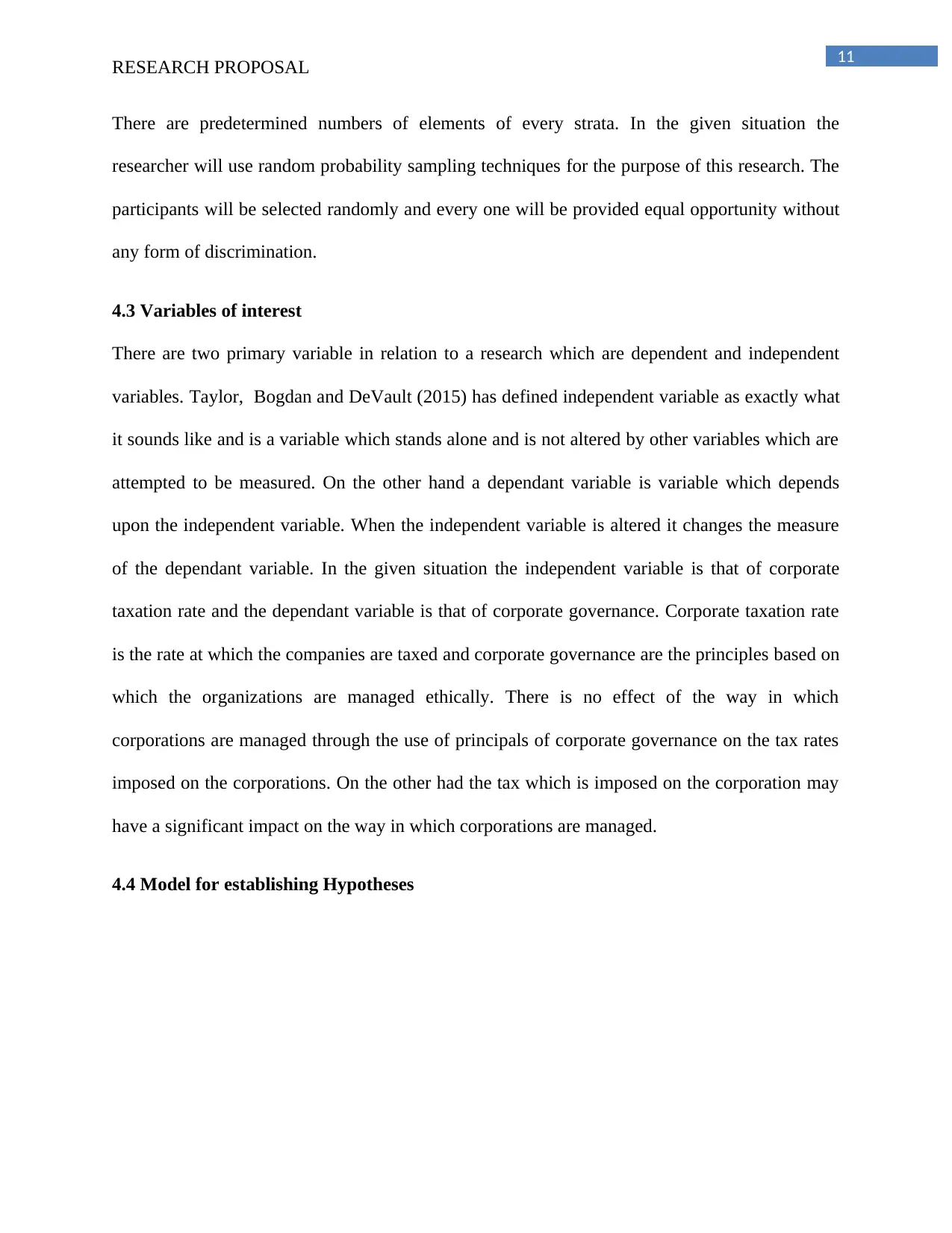
11
RESEARCH PROPOSAL
There are predetermined numbers of elements of every strata. In the given situation the
researcher will use random probability sampling techniques for the purpose of this research. The
participants will be selected randomly and every one will be provided equal opportunity without
any form of discrimination.
4.3 Variables of interest
There are two primary variable in relation to a research which are dependent and independent
variables. Taylor, Bogdan and DeVault (2015) has defined independent variable as exactly what
it sounds like and is a variable which stands alone and is not altered by other variables which are
attempted to be measured. On the other hand a dependant variable is variable which depends
upon the independent variable. When the independent variable is altered it changes the measure
of the dependant variable. In the given situation the independent variable is that of corporate
taxation rate and the dependant variable is that of corporate governance. Corporate taxation rate
is the rate at which the companies are taxed and corporate governance are the principles based on
which the organizations are managed ethically. There is no effect of the way in which
corporations are managed through the use of principals of corporate governance on the tax rates
imposed on the corporations. On the other had the tax which is imposed on the corporation may
have a significant impact on the way in which corporations are managed.
4.4 Model for establishing Hypotheses
RESEARCH PROPOSAL
There are predetermined numbers of elements of every strata. In the given situation the
researcher will use random probability sampling techniques for the purpose of this research. The
participants will be selected randomly and every one will be provided equal opportunity without
any form of discrimination.
4.3 Variables of interest
There are two primary variable in relation to a research which are dependent and independent
variables. Taylor, Bogdan and DeVault (2015) has defined independent variable as exactly what
it sounds like and is a variable which stands alone and is not altered by other variables which are
attempted to be measured. On the other hand a dependant variable is variable which depends
upon the independent variable. When the independent variable is altered it changes the measure
of the dependant variable. In the given situation the independent variable is that of corporate
taxation rate and the dependant variable is that of corporate governance. Corporate taxation rate
is the rate at which the companies are taxed and corporate governance are the principles based on
which the organizations are managed ethically. There is no effect of the way in which
corporations are managed through the use of principals of corporate governance on the tax rates
imposed on the corporations. On the other had the tax which is imposed on the corporation may
have a significant impact on the way in which corporations are managed.
4.4 Model for establishing Hypotheses
You're viewing a preview
Unlock full access by subscribing today!
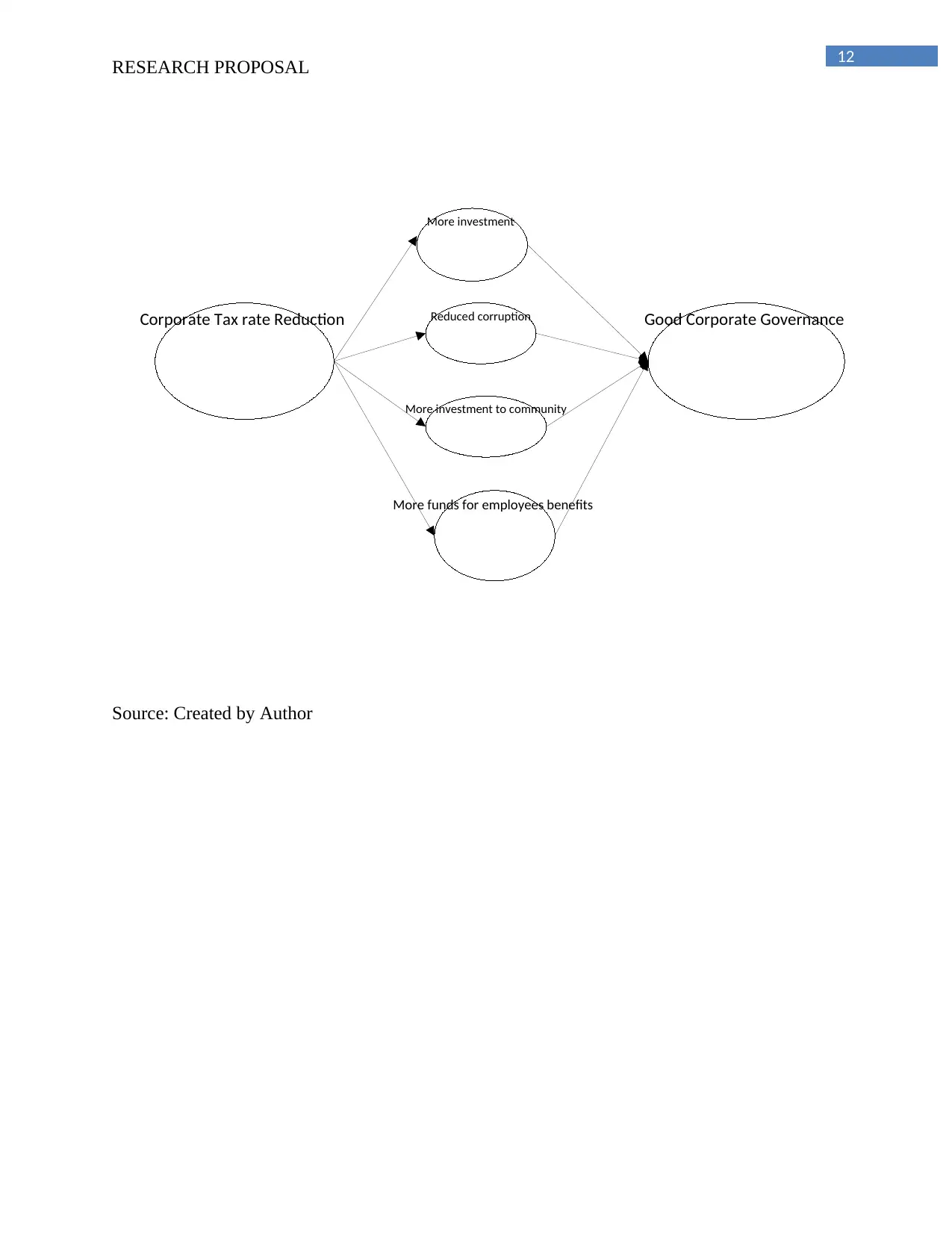
12
Corporate Tax rate Reduction Good Corporate Governance
More investment
Reduced corruption
More investment to community
More funds for employees benefits
RESEARCH PROPOSAL
Source: Created by Author
Corporate Tax rate Reduction Good Corporate Governance
More investment
Reduced corruption
More investment to community
More funds for employees benefits
RESEARCH PROPOSAL
Source: Created by Author
Paraphrase This Document
Need a fresh take? Get an instant paraphrase of this document with our AI Paraphraser
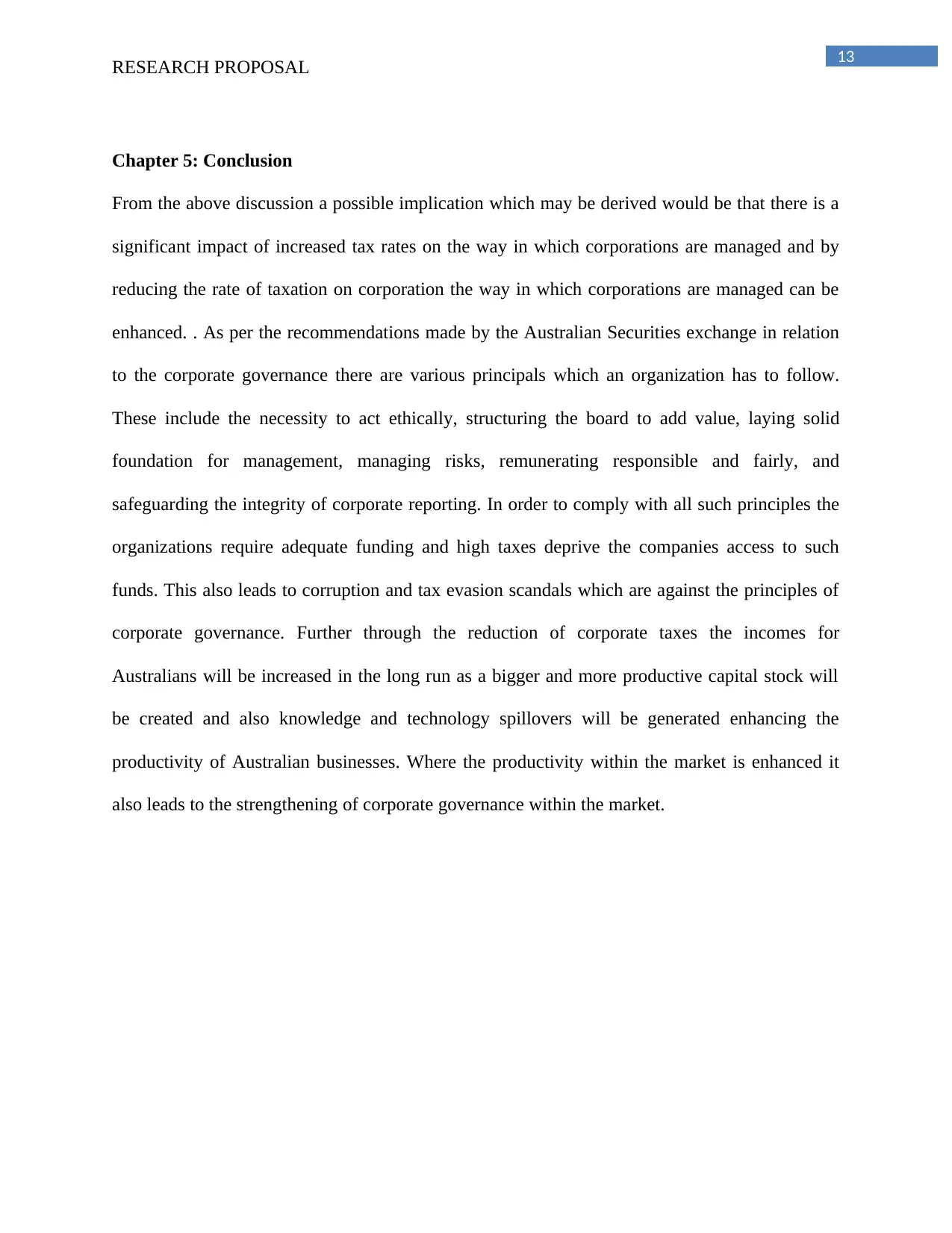
13
RESEARCH PROPOSAL
Chapter 5: Conclusion
From the above discussion a possible implication which may be derived would be that there is a
significant impact of increased tax rates on the way in which corporations are managed and by
reducing the rate of taxation on corporation the way in which corporations are managed can be
enhanced. . As per the recommendations made by the Australian Securities exchange in relation
to the corporate governance there are various principals which an organization has to follow.
These include the necessity to act ethically, structuring the board to add value, laying solid
foundation for management, managing risks, remunerating responsible and fairly, and
safeguarding the integrity of corporate reporting. In order to comply with all such principles the
organizations require adequate funding and high taxes deprive the companies access to such
funds. This also leads to corruption and tax evasion scandals which are against the principles of
corporate governance. Further through the reduction of corporate taxes the incomes for
Australians will be increased in the long run as a bigger and more productive capital stock will
be created and also knowledge and technology spillovers will be generated enhancing the
productivity of Australian businesses. Where the productivity within the market is enhanced it
also leads to the strengthening of corporate governance within the market.
RESEARCH PROPOSAL
Chapter 5: Conclusion
From the above discussion a possible implication which may be derived would be that there is a
significant impact of increased tax rates on the way in which corporations are managed and by
reducing the rate of taxation on corporation the way in which corporations are managed can be
enhanced. . As per the recommendations made by the Australian Securities exchange in relation
to the corporate governance there are various principals which an organization has to follow.
These include the necessity to act ethically, structuring the board to add value, laying solid
foundation for management, managing risks, remunerating responsible and fairly, and
safeguarding the integrity of corporate reporting. In order to comply with all such principles the
organizations require adequate funding and high taxes deprive the companies access to such
funds. This also leads to corruption and tax evasion scandals which are against the principles of
corporate governance. Further through the reduction of corporate taxes the incomes for
Australians will be increased in the long run as a bigger and more productive capital stock will
be created and also knowledge and technology spillovers will be generated enhancing the
productivity of Australian businesses. Where the productivity within the market is enhanced it
also leads to the strengthening of corporate governance within the market.

14
RESEARCH PROPOSAL
References
Armstrong, C.S., Blouin, J.L., Jagolinzer, A.D. and Larcker, D.F., 2015. Corporate governance,
incentives, and tax avoidance. Journal of Accounting and Economics, 60(1), pp.1-17.
Arnold, J.M., Brys, B., Heady, C., Johansson, Å., Schwellnus, C. and Vartia, L., 2011. Tax
policy for economic recovery and growth. The Economic Journal, 121(550).
Balakrishnan, K., Blouin, J. and Guay, W., 2018. Tax Aggressiveness and Corporate
Transparency. The Accounting Review.
Donohoe, M.P. and Robert Knechel, W., 2014. Does corporate tax aggressiveness influence
audit pricing?. Contemporary Accounting Research, 31(1), pp.284-308.
Gravelle, J., 2013. Corporate tax incidence: review of general equilibrium estimates and
analysis. National Tax Journal, 66(1), p.185.
Gravelle, J.G., 2009. Tax havens: International tax avoidance and evasion. National Tax Journal,
pp.727-753.
Hoi, C.K., Wu, Q. and Zhang, H., 2013. Is corporate social responsibility (CSR) associated with
tax avoidance? Evidence from irresponsible CSR activities. The Accounting Review, 88(6),
pp.2025-2059.
Huseynov, F. and Klamm, B.K., 2012. Tax avoidance, tax management and corporate social
responsibility. Journal of Corporate Finance, 18(4), pp.804-827.
Jiraporn, P., Kim, J.C. and Kim, Y.S., 2011. Dividend payouts and corporate governance quality:
An empirical investigation. Financial Review, 46(2), pp.251-279.
RESEARCH PROPOSAL
References
Armstrong, C.S., Blouin, J.L., Jagolinzer, A.D. and Larcker, D.F., 2015. Corporate governance,
incentives, and tax avoidance. Journal of Accounting and Economics, 60(1), pp.1-17.
Arnold, J.M., Brys, B., Heady, C., Johansson, Å., Schwellnus, C. and Vartia, L., 2011. Tax
policy for economic recovery and growth. The Economic Journal, 121(550).
Balakrishnan, K., Blouin, J. and Guay, W., 2018. Tax Aggressiveness and Corporate
Transparency. The Accounting Review.
Donohoe, M.P. and Robert Knechel, W., 2014. Does corporate tax aggressiveness influence
audit pricing?. Contemporary Accounting Research, 31(1), pp.284-308.
Gravelle, J., 2013. Corporate tax incidence: review of general equilibrium estimates and
analysis. National Tax Journal, 66(1), p.185.
Gravelle, J.G., 2009. Tax havens: International tax avoidance and evasion. National Tax Journal,
pp.727-753.
Hoi, C.K., Wu, Q. and Zhang, H., 2013. Is corporate social responsibility (CSR) associated with
tax avoidance? Evidence from irresponsible CSR activities. The Accounting Review, 88(6),
pp.2025-2059.
Huseynov, F. and Klamm, B.K., 2012. Tax avoidance, tax management and corporate social
responsibility. Journal of Corporate Finance, 18(4), pp.804-827.
Jiraporn, P., Kim, J.C. and Kim, Y.S., 2011. Dividend payouts and corporate governance quality:
An empirical investigation. Financial Review, 46(2), pp.251-279.
You're viewing a preview
Unlock full access by subscribing today!
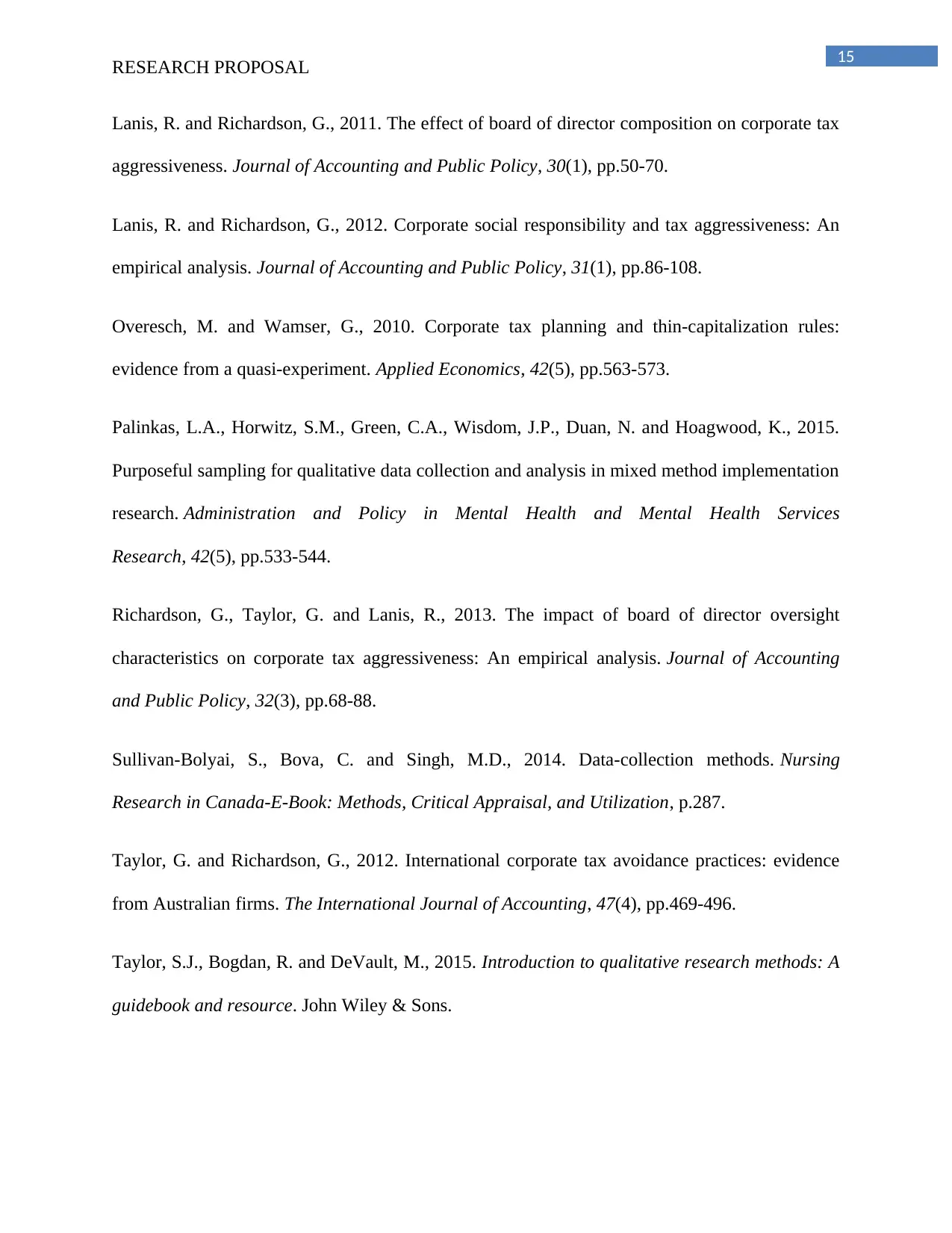
15
RESEARCH PROPOSAL
Lanis, R. and Richardson, G., 2011. The effect of board of director composition on corporate tax
aggressiveness. Journal of Accounting and Public Policy, 30(1), pp.50-70.
Lanis, R. and Richardson, G., 2012. Corporate social responsibility and tax aggressiveness: An
empirical analysis. Journal of Accounting and Public Policy, 31(1), pp.86-108.
Overesch, M. and Wamser, G., 2010. Corporate tax planning and thin-capitalization rules:
evidence from a quasi-experiment. Applied Economics, 42(5), pp.563-573.
Palinkas, L.A., Horwitz, S.M., Green, C.A., Wisdom, J.P., Duan, N. and Hoagwood, K., 2015.
Purposeful sampling for qualitative data collection and analysis in mixed method implementation
research. Administration and Policy in Mental Health and Mental Health Services
Research, 42(5), pp.533-544.
Richardson, G., Taylor, G. and Lanis, R., 2013. The impact of board of director oversight
characteristics on corporate tax aggressiveness: An empirical analysis. Journal of Accounting
and Public Policy, 32(3), pp.68-88.
Sullivan-Bolyai, S., Bova, C. and Singh, M.D., 2014. Data-collection methods. Nursing
Research in Canada-E-Book: Methods, Critical Appraisal, and Utilization, p.287.
Taylor, G. and Richardson, G., 2012. International corporate tax avoidance practices: evidence
from Australian firms. The International Journal of Accounting, 47(4), pp.469-496.
Taylor, S.J., Bogdan, R. and DeVault, M., 2015. Introduction to qualitative research methods: A
guidebook and resource. John Wiley & Sons.
RESEARCH PROPOSAL
Lanis, R. and Richardson, G., 2011. The effect of board of director composition on corporate tax
aggressiveness. Journal of Accounting and Public Policy, 30(1), pp.50-70.
Lanis, R. and Richardson, G., 2012. Corporate social responsibility and tax aggressiveness: An
empirical analysis. Journal of Accounting and Public Policy, 31(1), pp.86-108.
Overesch, M. and Wamser, G., 2010. Corporate tax planning and thin-capitalization rules:
evidence from a quasi-experiment. Applied Economics, 42(5), pp.563-573.
Palinkas, L.A., Horwitz, S.M., Green, C.A., Wisdom, J.P., Duan, N. and Hoagwood, K., 2015.
Purposeful sampling for qualitative data collection and analysis in mixed method implementation
research. Administration and Policy in Mental Health and Mental Health Services
Research, 42(5), pp.533-544.
Richardson, G., Taylor, G. and Lanis, R., 2013. The impact of board of director oversight
characteristics on corporate tax aggressiveness: An empirical analysis. Journal of Accounting
and Public Policy, 32(3), pp.68-88.
Sullivan-Bolyai, S., Bova, C. and Singh, M.D., 2014. Data-collection methods. Nursing
Research in Canada-E-Book: Methods, Critical Appraisal, and Utilization, p.287.
Taylor, G. and Richardson, G., 2012. International corporate tax avoidance practices: evidence
from Australian firms. The International Journal of Accounting, 47(4), pp.469-496.
Taylor, S.J., Bogdan, R. and DeVault, M., 2015. Introduction to qualitative research methods: A
guidebook and resource. John Wiley & Sons.
Paraphrase This Document
Need a fresh take? Get an instant paraphrase of this document with our AI Paraphraser

16
RESEARCH PROPOSAL
RESEARCH PROPOSAL
1 out of 17
Related Documents
Your All-in-One AI-Powered Toolkit for Academic Success.
+13062052269
info@desklib.com
Available 24*7 on WhatsApp / Email
![[object Object]](/_next/static/media/star-bottom.7253800d.svg)
Unlock your academic potential
© 2024 | Zucol Services PVT LTD | All rights reserved.





